News

Rising Waters: Aging Levees, Climate Change And The Challenge To Hold Back The Ohio River
By: Liam Niemeyer | Ohio Valley ReSource
Posted on:
When 78-year-old Jim Casto looks at the towering floodwalls that line downtown Huntington, West Virginia, he sees a dark history of generations past.
The longtime journalist and local historian is short in stature, yet tall in neighborhood tales. On Casto’s hand shines a solid gold ring, signifying his more than 40 years of reporting at the local paper. “It was a lot cheaper to give me a ring than to give me a pay raise,” he said with a chuckle.
He walks up to the entrance of Harris Riverfront Park, one of 21 gate openings in the more than 3.5 miles of floodwalls covered in decades of charcoal-colored grime and dirt.
The river has shaped the city, providing the transportation for coal, steel and chemical products. But Casto also knows the river has the power to destroy, as it did before the omnipresent walls were there.
Casto published a photobook on the most destructive flood the Ohio River Valley has seen.
“January of 1937 was exceptionally warm. And that meant that the snow on the hillsides melted much earlier than usual and faster than usual. Then, there were 19 consecutive days of rain,” Casto said.
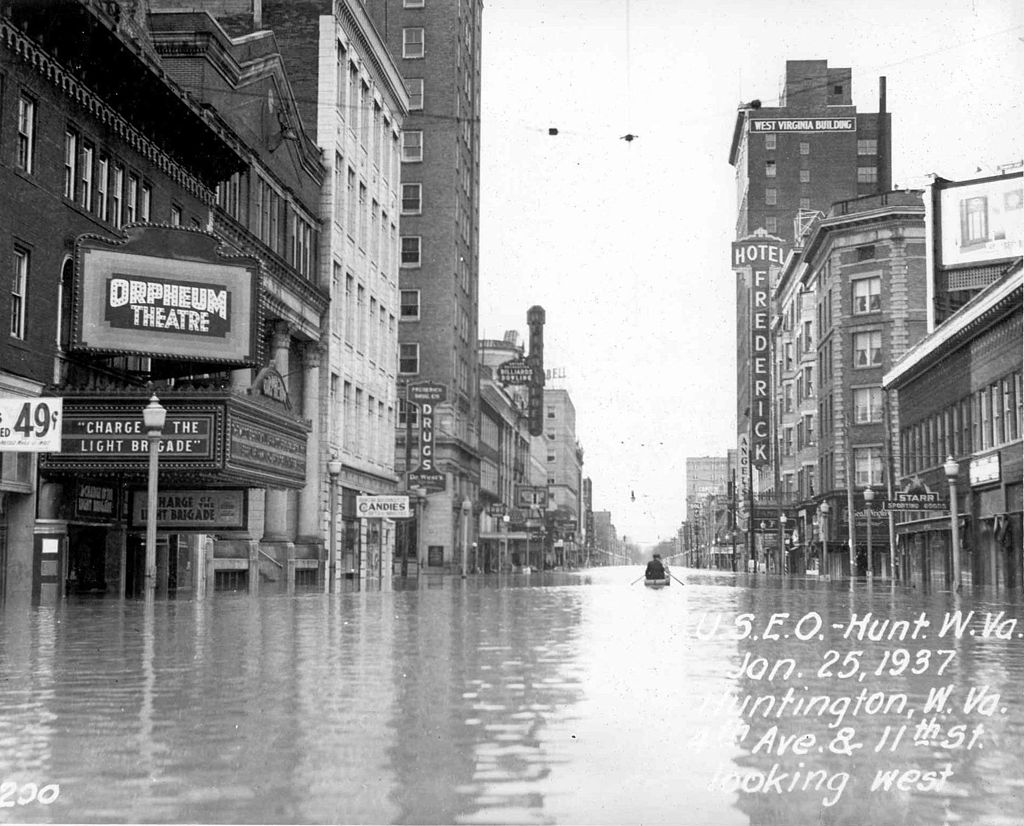
“That is the ’37 flood,” he said. The river rose to nearly 20 feet above flood stage — more than 69 feet high.
Thousands of Huntington residents were forced from their homes. The county courthouse became a virtual port for rescue boats.
“As Time magazine in ’37 described it: ‘Hell and High Water,’” Casto said.
Ohio River communities from Pittsburgh to Cairo, Illinois, were inundated. About a million people were left homeless; 385 people were killed; and the flood, adjusted for current inflation, caused an estimated $9.12 billion in damages.
In the wake of the disaster, the U.S. Army Corps of Engineers took on a mammoth effort to construct hundreds of miles of levees, floodwalls and numerous pump stations to keep back rising water. Those defenses are now, on average, nearly 60 years old. Huntington’s system was built in 1943, one of the oldest in the basin.
![A map shows levee risk in the Ohio River Watershed]](https://woub.org/wp-content/uploads/2019/12/levee-by-risk-v4-768x675-1.png)
Huntington is one of a dozen levee systems in the basin that the Corps of Engineers classifies as a “high risk” due to the combination of aging infrastructure and the people and property that would be harmed if the system were to fail. The American Society of Civil Engineers estimates aging levee systems like these across the country will need $80 billion in upgrades within the next decade.
The challenge is made greater by the growing menace of climate change. A warmer, wetter climate could intensify the severity and frequency of flooding and send up to 50% more water flowing through Ohio Valley waterways within this century.
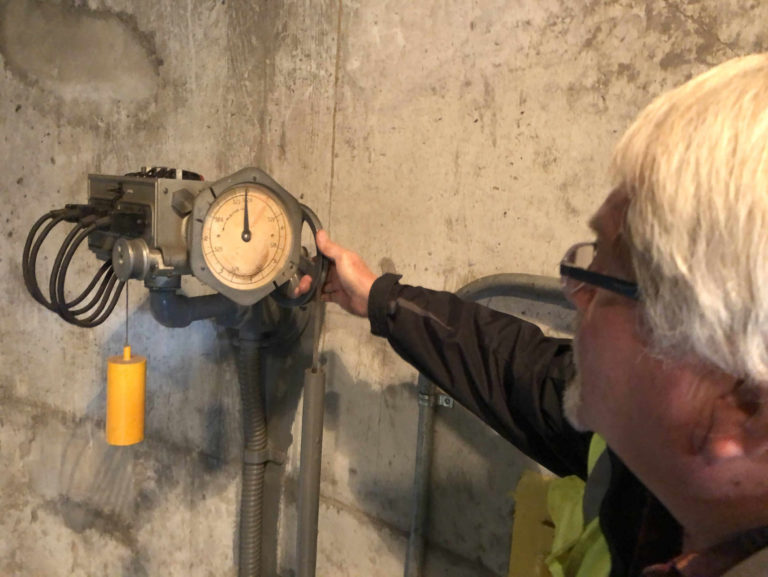
Aging protection
With the twist of a cold handle, a heavy, metal door creaks open, the sound echoing throughout the cavernous Pump Station Number Six on the west side of Ironton, Ohio, along the Ohio River.
“Like going into the Frankenstein laboratory, wasn’t it?” said Mike Pemberton, who’s managed flood defense for decades in the city of more than 10,000 people, a half-hour downstream from Huntington. Four gigantic red pumps protrude 10 feet from the ground below a raised platform, where large, green electrical switchboards from the 1940s take up most of the space.
Pemberton motions to a sensor with a weighted pulley that uses mercury to tell how much water is being pumped during high water; modern equipment, on the other hand, would be computerized. He said it’s fairly reliable, but sometimes the mercury container collects a film of carbon material that he shakes off.
“Slap the side of it, and sometimes that’ll clean the carbon off the mercury,” Pemberton said.
Ironton’s flood defense system of pump stations, levees and floodwalls were also built in the 1940s, much like in Huntington. The sensor is something he can see and more easily maintain. Yet some things remain outside his experienced sight, including the more than half-century-old pipes that run through the station and the sluice gates that seal water from flooding the station itself.
“We don’t know the condition of the inside of that pipe. We don’t know if that gate could have a stress crack in it,” Pemberton said. “That’s some of the things I kind of worry about.”
Pemberton’s maintenance worries extend far beyond to nine other archaic pump stations, almost 4 miles of earthen levee and over another mile of floodwall. He said a local tax levy that generates about $260,000 a year for his department mostly funds salaries for three employees and daily maintenance on the flood protection system. That includes tasks such as mowing the grass on top of levees and greasing pump motors.
Ironton voted in 2014 to double the tax levy. Pemberton campaigned for the measure by hanging signs marking the 1937 flood level throughout the city’s historic downtown, reaching the second floor of many buildings.
Ironton City Council also passed an ordinance in 2018 that created a monthly $5 flood protection fee tacked onto utility bills. That revenue goes into a Flood Improvement Fund that had a little more than $200,000 as of late November, according to the city’s finance director. Ironton’s per capita income is about $20,000 and the city’s poverty rate hovers at 20%, but the city didn’t have many other options.
“To nobody’s knowledge was there anywhere, any kind of money available to go after that would meet the kind of needs, and there was an immediate need,” said Jim Tordiff, the former Ironton councilman who drafted the ordinance. “It had gone on too long and couldn’t be ignored.”
But Pemberton said even with the extra local funding, the glaring, long-term problems still pile up.
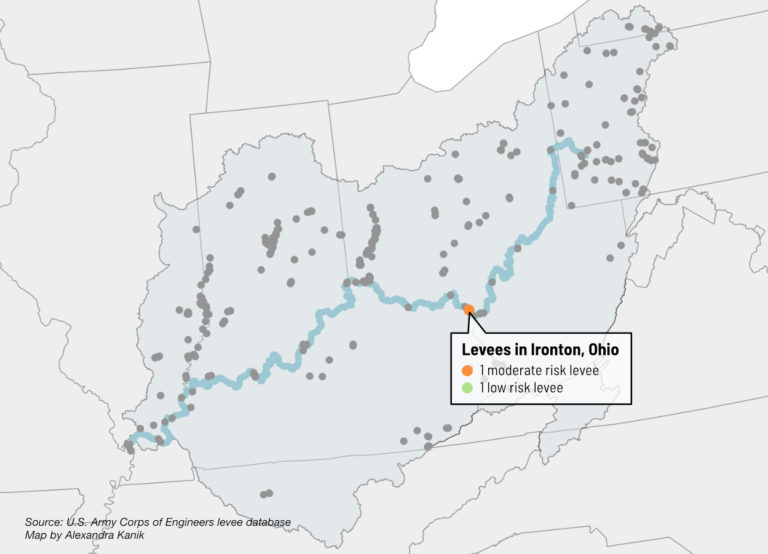
But he can’t rely on insurance for the future, he said, as all of his stations have the same outdated switchgears that could fail. He estimates each station would cost around the same amount to receive an upgrade — money he and other Ohio River communities in similar situations struggle to find.
“You can imagine the maintenance and repairs and the parts and pieces that it would take and the cost it would take to keep a 1940 car on the road today,” said Sherry Wilkins, director of the Huntington Stormwater Utility. “That’s kind of what we’re dealing with here, we’re dealing with an 80-year-old system.”
Wilkins said Huntington encounters a lot of the type of problems with an aging system that Pemberton described in Ironton.

“Our floodwall has a 50-year design life,” Wilkins said, meaning that obscure replacement parts must be custom-made and can cost thousands of dollars. “The average person wouldn’t think of that, ‘Wow, does it really cost $20,000 to repair a pump?’ So, currently we don’t have the money to do those kinds of things continually.”
Wilkins said grant funding is tight because of competition with dozens of other municipalities in need. And in older cities, other aging infrastructure issues may be a higher priority when it comes to applying for grants.
If there were a flood that damaged Huntington’s downtown floodwall, the Corps of Engineers would not help the city pay for repairs.
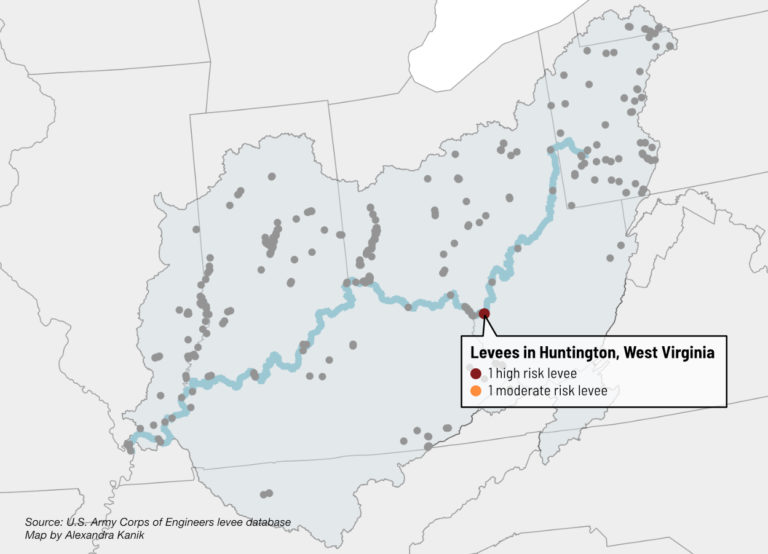
If the inspection is considered at least “minimally acceptable,” the Corps will cover damage from a disaster.
The reason Huntington’s downtown floodwall does not qualify? A sinkhole, almost the size of a car, threatens to swallow up ground near the city’s 11th Street Pump Station.
“It’s not just Huntington, it’s every single floodwall that was built in the 1930s, 1940s. It is not a luxury. It is a necessity,” Wilkins said. “It’s a problem nationwide.”
With scientists predicting warmer temperatures and more frequent flooding due to climate change, the urgency is growing to address aging infrastructure.
Warmer, wetter future
Huntington as warm as Los Angeles. Cincinnati as hot as Atlanta: Those are just some of the predicted temperature rises in the Ohio River basin in the coming century, according to a 2017 report studying the effects of climate change. The Army Corps, the National Weather Service, regional universities and other federal and state partners worked on the study.

Already, several cities in the region saw record rainfall in 2018. Cincinnati saw its third wettest year, and Charleston, Pittsburgh, Columbus and Louisville all saw their wettest year ever.
Some levee systems in parts of the Ohio River basin — including Huntington and Ironton — could see an average annual river streamflow increase of 25% to 35% by 2099. That increases the chance of another flood on the scale of the historic one in 1937.
Noel said the Ohio River basin today has several extra protections beyond the floodwalls and levees, such as dams and reservoirs along tributary rivers, that help control water levels before they reach levee systems.
“The 1937 flood happened before most of the flood control projects in the Ohio basin,” Noel said. “Therefore, for example, like if you look at Cincinnati, Ohio, or Louisville, Kentucky, those kind of cities, if 1937 were to exactly repeat itself, the crest on the Ohio River would be some 8 to 10 feet lower in many locations because of the great ability of the Army Corps of Engineers to regulate that flow in that water through their flood control projects.”
And the height of some older floodwalls and levees could already be capable of handling higher waters, according to Kate White who led the 2017 Corps study.
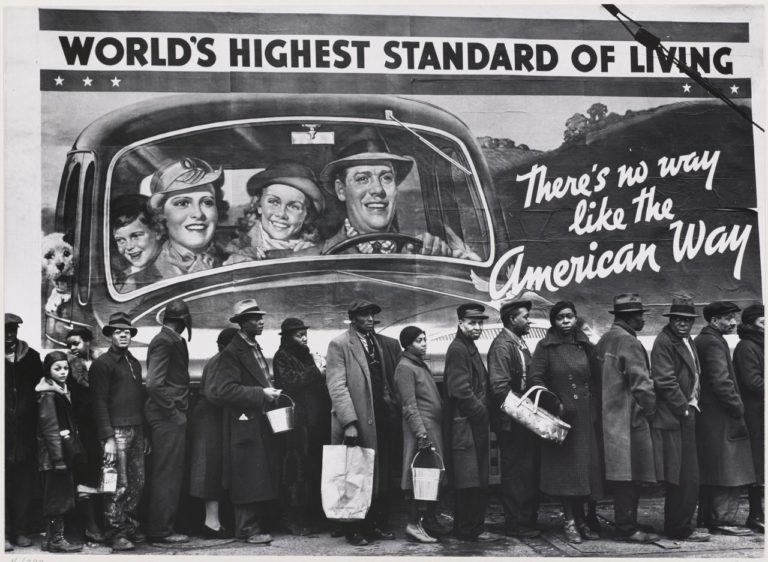
“I just think there are older things that are still perfectly fine if they’ve been maintained and looked after,” White said.
Flood protection managers including Pemberton, Wilkins and others along the Ohio River generally agree that stationary floodwalls and earthen levees are relatively solid compared to the moving parts of pump station equipment.
Army Corps Huntington District Levee Safety Program Manager John Ferguson said he expects all the levee systems in the upper Ohio Valley to perform as expected. But the increasing age is still a question.
“Maybe the general consensus on most of these projects is a 50-year design life, but again, that’s not a hard or fast rule that really means anything,” Ferguson said. “And yes, that just proves that it’s aging infrastructure like everything else in the country. We just got to take care of it and make sure we maintain it.”
Army Corps officials like Ferguson are relying on a system called Levee Safety Action Classification to help prioritize which aging levee systems carry more risk. A levee gets a risk classification based on its condition and the people and property it protects.
Twelve levee systems in the Ohio River basin have a “high” risk classification, including in Huntington, Louisville and systems protecting cities as small as Brookport, Illinois. This classification calls on officials to increase the “frequency of levee monitoring” and ensure the “community is aware of flood warning and evacuation procedures.”
The risk surrounding aging levees was a prominent topic at a Huntington meeting in November among several local levee project managers. Corps officials, including Ferguson, recommended that managers join forces to be a louder voice for federal funding.
 “It’s a completely different story if you have every project, from Parkersburg to Maysville, that raises their hand and says, ‘Hey, we’ve got aging infrastructure,’” Ferguson said. “If there’s a lot of ‘squeaky wheels,’ it gets a lot of grease.”
“It’s a completely different story if you have every project, from Parkersburg to Maysville, that raises their hand and says, ‘Hey, we’ve got aging infrastructure,’” Ferguson said. “If there’s a lot of ‘squeaky wheels,’ it gets a lot of grease.”
Pemberton in Ironton said there was once an association of regional floodwall managers who advocated for infrastructure improvements, but that group dissolved in the early 2000s. He isn’t sure what future flooding from climate change will look like, but he said he believes banding flood defense managers together will help alleviate some of the uncertainty.
And when Pemberton hears about climate change from local meteorologists, the nagging worries he has for the future only continue to dog him.
“‘What if’ I guess [are] the two big words. ‘What if?’”
Liam Niemeyer, a reporter for Ohio Valley ReSource, authored this story. He can be reached at lniemeyer1@murraystate.edu.
Good River: Stories of the Ohio is a series about the environment, economy and culture of the Ohio River watershed, produced by seven nonprofit newsrooms. To see more, please visit ohiowatershed.org.

